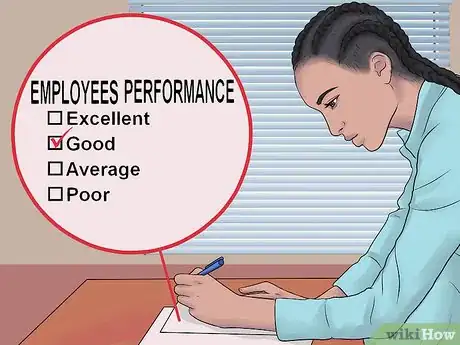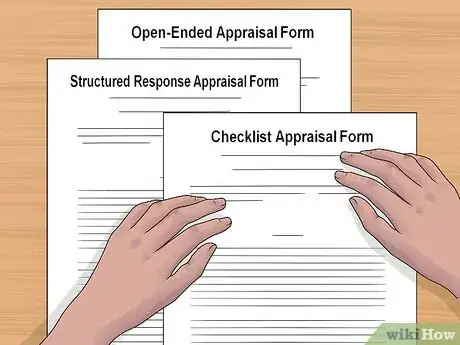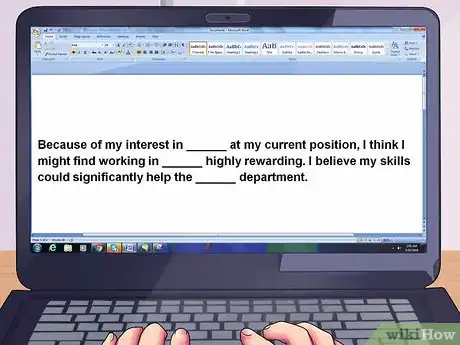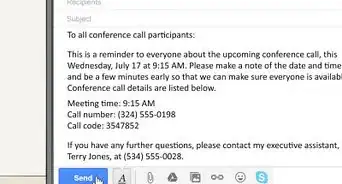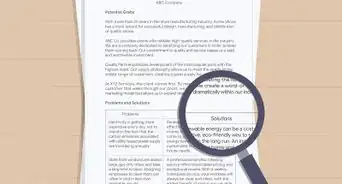This article was co-authored by Michael R. Lewis. Michael R. Lewis is a retired corporate executive, entrepreneur, and investment advisor in Texas. He has over 40 years of experience in business and finance, including as a Vice President for Blue Cross Blue Shield of Texas. He has a BBA in Industrial Management from the University of Texas at Austin.
There are 9 references cited in this article, which can be found at the bottom of the page.
This article has been viewed 61,677 times.
Performance appraisals, also called performance reviews, are used to evaluate an employee's work at their job. Many performance appraisals are completed by the employee's manager, though some employers may ask employees to appraise their own work or others' work and complete a self-evaluation. Whether you're writing a review of your employees' work or your own work, learning how to write a performance review can help you clarify the roles and responsibilities of everyone at your place of business.
Steps
Preparing to Review an Employee's Performance
-
1Update that position's description. Before you begin reviewing an employee's performance, you should double-check that employee's description in your employment files. If the position's requirements or functions have changed at all in the last few years, that description will need to be updated.
- It would be unfair to the employee to evaluate them based on outdated position descriptions.
- Recognize the work that employee has done and the work they're expected to do this year, not in years past.
- Update the description to include any special skills or knowledge required to do the work and/or any specific tools or equipment needed.
-
2Identify expectations based on job roles/functions. In addition to reviewing the position description, you should also review the essential performance functions of that position. These functions will help you identify your own expectations for that employee. Performance functions vary by job, but they generally include:
- Accountability: This covers whether the employee is reliable and consistent. Accountability may include punctuality, ability to meet deadlines, respect for the organization and its employees, and ability to meet or exceed performance expectations.
- Production standards: These should be objective, measurable accomplishments performed within specific time frames. For example, a person picking stock in a distribution center might be expected to pick 100 pieces an hour.
- Job knowledge: This may include the employee's professional skills, ability to assist coworkers, and willingness to continue developing their knowledge and abilities. Required knowledge might also include operating, maintaining, and instructing others with special tools and equipment.
- Communication: This may include communication skills, or it may cover an employee's ability to work collaboratively and seek feedback from other employees.
- Interpersonal relations: This generally deals with how the employee treats their colleagues, and whether the employee is tactful and respectful of others.
- Customer service: If the employee's position involves customer service, you may want to include evaluations on patience, approachability, reliability, and the employee's commitment to following up with customers as needed.
Advertisement -
3Review last year's performance appraisal. As you prepare to assess an employee's performance over the past year, it's important to review what you (or perhaps another manager) said about that employee last year. There may be significant improvements made, or the employee's performance may have gotten worse; either way, you should know in advance where things stand.[1]
- Look into performance reviews for the past three years, especially noting whether such reviews have been performed by other people. Note any employee comments about past reviews.
-
4Document the employee's performance. The best way to begin a performance appraisal is to document the work that a given employee has done. Take note of both what the employee has done in their position and how they did it, whether the things you document are good or bad. Reviews should be as objective as possible based upon viewable, measurable results. If subjectivity is required, note justifications in the review.
- In order to complete a performance appraisal, you will need to decide on some type of measurable, quantitative method of documenting and evaluating performance.[2]
- Any time an employee commits an infraction, it needs to be documented in that employee's personnel file. These infractions should be reviewed and compiled during that employee's performance appraisal.[3]
- Tie any performance praise or infraction reprimand with specific rules and policies at work. Make sure all rules and policies are enforced equally for all employees.
-
5Get feedback from the employee and their co-workers. An important part of the appraisal process for many employers is seeking feedback from each employee's coworkers and from the employee himself or herself. This allows managers to get a better feel for how an individual views their job and how that employee's coworkers view their performance.
- Ask an employee's coworkers how that individual performs at work, both independently and in collaboration with others.
- You should specifically ask about both the accomplishments of that employee and any areas that their colleagues believe need improvement.
- Remember that co-workers' comments are always subjective and often based upon their relationship with employee. Rather than relying upon single interviews, indicate the use of 360-degree appraisals.
-
6Give your employee regular feedback between performance reviews. Your employees should not go into their performance reviews feeling blindsided. If there are elements of an employee's performance that need improvement, let that employee know in a casual (yet professional) way. Likewise, if an employee is doing a good job, give that person praise when you see them at work.[4]
- The employer should have written history of any reviews and feedback, with evidence that the employee understands the reason for a negative comment and the expectations for improvement.
Evaluating an Employee's Performance
-
1Choose an appraisal format. Before you begin an employee's performance appraisal, you'll need to decide how to review that employee's work. There are several different ways of organizing/structuring your appraisal. Three of the most common include:
- Open-ended: Rather than using a rating scale, an open-ended appraisal is an open-ended written evaluation that can include any thoughts that the appraiser chooses to include. This format is preferable if you only manage a small number of people.
- Structured response: The structured response appraisal is a middle-ground between open-ended and checklist evaluations. It consists of a series of topics/questions within a set of performance parameters, which you fill in according to the employee's performance.
- Remember that these responses need to be based on observation of results, not speculation of motive or attitude.
- Checklist: The checklist appraisal is generally used by managers with a large number of employees to evaluate. It consists of a list of performance appraisals and a numerical ranking of how a given employee performs in each category (for example, on a scale of 1 to 5).
- Ranking employees in groups against others can be an effective way to recognize low performance. Many company automatically terminate the lowest 10 percent if no improvement is made.
-
2Consider what's actually been achieved. It can be very easy to confuse accomplishments and achievements with activities. Activities are what workers perform on a day-to-day basis by coming to work; accomplishments are the results or outcomes of an employee's activities and hard work.[5]
- As you assess an employee's performance, you'll need to distinguish between that employee doing their job and actually accomplishing things for the company.
- Make a point of praising good work on the employee's part, but have concrete accomplishments to praise.[6]
- You should especially praise good work if the employee is doing the work of multiple people. Many employees get saddled with extra work after downsizing, yet they never get recognition for that extra effort.
- Focus on the entire reporting period (most likely a year). Focusing on one bad incident from the last month and ignoring the last 11 months of flawless work is unfair and unhelpful for most employees.
-
3Justify each part of the evaluation. It may seem obvious, but a performance appraisal is only valuable to the employee if it provides specific feedback on areas that need improvement. It should also address specific things the employee is doing well, and provide encouragement in all areas of performance.[7]
- Dedicate time to each individual objective being reviewed. Be honest and fair in your assessment, and don't play favorites among your employees.
- Support every score on the evaluation, whether good or bad, with written comments and feedback.[8]
- Make sure your criticism (if any) is constructive. It's not helpful to tell someone they're bad at doing something; instead, tell them how to improve that aspect of their job.
- As a manager, ask and focus on how you can help employee reach goals. In other words, be people-oriented to achieve high standards, rather than process-oriented.
- Focus on each employee's strengths and weaknesses, and be sure to give your employee new performance goals for the coming year.[9]
- Let employees know that improvement can lead to benefits like a salary increase or a promotion to a better position.
-
4Set SMART goals and objectives for the position. If the employee has areas that need to improve, you'll need to give that individual the tools to improve their performance. The best goals are called S.M.A.R.T. goals, an acronym for Specific, Measurable, Attainable, Relevant, and Time-bound.
- Specific goals should use exact language and target the precise aspects of performance that need improvement. For example, instead of saying "Make better sales calls," you might suggest that the employee work on their tone and pitch with customers.
- Measurable goals should be easily tracked. You should have a clear indication of what needs to be done, how much change needs to be made, and when it needs to happen by.
- Attainable goals are realistic and feasible for an employee to accomplish. Rather than expecting an employee to single-handedly turn the company around, you should expect that employee to improve their sales numbers, for example.
- Relevant goals link the employee's performance with quantifiable results that relate to their function in the workplace. For example, a customer service employee may be asked to increase the number of disgruntled callers they're able to keep as customers.
- Time-bound goals have a specific start and end date. For example, a time-bound goal might be to improve customer satisfaction ratings within the next six months.
-
5End the review on a positive note. Even the most critical performance appraisal should end with something positive. As a manager, you'll have to evaluate the work an employee has done to find something positive you can commend.[10]
- It's typically easier to take critical feedback if the review ends with something positive.
- Think about everything that employee has done over the last year, including how that employee interacts with other colleagues, to find something positive you can praise.
-
6Follow up with quarterly or mid-year reviews. While annual reviews are very common, some managers like to follow up with employees between those big reviews. These may be done quarterly or at the mid-year point, but the goal is to evaluate each employee's progress so that the employee isn't blindsided by more criticism during the next annual review.[11]
- You can follow up with employees through formal performance appraisals, or informally through a one-on-one conversation with each employee (if this is feasible).
- Praise improvements and corrective changes the employee has made. Give them credit for all their hard work.
- Point out any performance aspects that have not improved with your recommendations or have gotten worse since last year's review.
Completing a Self-Evaluation
-
1Give yourself enough time to reflect and plan a response. Your self-evaluation may be what your manager basis your performance review on, or it may simply be a tool to assess how you feel you're progressing. Either way, it's important that you think carefully about what you want to say about your work.
- You should never rush through a self-evaluation. That appraisal may end up in your personnel file, or it could be reviewed when you're up for a promotion, so make it count.
- You shouldn't need weeks and weeks to plan a response, but you may want to take at least a day or two to look back on everything you've done in the last year.
-
2Assess your work honestly. Your self-evaluation shouldn't be a giant pat on your own back. It should be an honest assessment of your performance over the last year, factoring in both the good and bad aspects of your work.[12]
- Avoid false modesty and take credit for your achievements.
- By the same token, though, make sure you don't inflate your performance assessment either.
- Try to frame your shortcomings as learning experiences. For example, you might say, "I lost three customers this year; however, in the process, I learned more efficient ways of keeping customers satisfied with our performance, which will help keep future customers with us."
-
3Acknowledge how you meet your responsibilities. In any self-evaluation, it's a good idea to begin by acknowledging what is expected from someone working in your position at your employer. This helps establish a baseline by which your performance can be evaluated.
- If using an open-ended format, spend a few sentences addressing what your position entails. Then address how you actually meet (or fail to meet) those responsibilities, and suggest ways you might improve your work.
- For example, you might start by writing a sentence or two on what's typically expected from your position. Then spend the rest of the paragraph talking about how you meet, fail to meet, or exceed those expectations.
- If using a structured or checklist format, your evaluation should already include some general markers of what's expected of your position (usually included in the questions). Rate your work based on how well you actually meet those expectations.
- Include performance competencies for both your professional skills and your behavior in the workplace, no matter what format you're using.
-
4Identify areas that could use improvement. Your self-evaluation should include some aspects of your performance that need work. You shouldn't be self-loathing in your assessment, but you should be able to realistically identify things that you could be doing differently.[13]
- If you're not sure about how to write about areas of improvement for yourself, ask a trusted colleague or manager how to proceed with this part of the evaluation.
- The key is to write about your shortcomings as a learning experience. For example, instead of saying "I lose a lot of clients," you might say, "One area in need of improvement is managing ongoing client relationships. I've learned from experience that ______ is the best approach."
- Talk about specific instances where you struggled with a project but managed to learn something valuable (ideally after succeeding with that project).
-
5Use the self-evaluation as an opportunity. While different employers use self-evaluations in different ways, one thing is common: you can use this space to talk about what you want for your professional future. Don't be pushy or demanding, but offer hints of where you see yourself in the next few years at that company.[14]
- Talk about the aspects of your current position that you find most exciting.
- Suggest some different ways that you can focus more time and attention on the things that excite you.
- Ask about being included in meetings that deal with those exciting job elements, or request time and/or funding to enroll in some type of continued education or training opportunities.
- For example, you might say, "Because of my interest in _____ at my current position, I think I might find working in _____ highly rewarding. I believe my skills could significantly help the _____ department.
- Use these discussion points to subtly hint that you'd like to take on more responsibility at your workplace. Over time, taking on more responsibility could lead to a promotion or a raise.
References
- ↑ http://money.usnews.com/money/blogs/outside-voices-careers/2015/12/07/assess-your-skills-weaknesses-in-a-performance-review
- ↑ https://humanresources.umn.edu/supervising-u/performance-management
- ↑ www.delmar.edu/WorkArea/DownloadAsset.aspx?id=4931
- ↑ http://www.businessnewsdaily.com/5760-write-good-performance-review.html
- ↑ https://www.opm.gov/policy-data-oversight/performance-management/measuring/employee_performance_handbook.pdf
- ↑ http://www.forbes.com/sites/ericjackson/2012/01/09/ten-reasons-performance-reviews-are-done-terribly/#68a9aa9959c3
- ↑ http://www.forbes.com/sites/ericjackson/2012/01/09/ten-reasons-performance-reviews-are-done-terribly/#68a9aa9959c3
- ↑ http://www.cscc.edu/about/human-resources/forms/evaluation.pdf
- ↑ http://www.businessnewsdaily.com/5760-write-good-performance-review.html
- ↑ http://www.businessnewsdaily.com/5760-write-good-performance-review.html
- ↑ http://www.forbes.com/sites/ericjackson/2012/01/09/ten-reasons-performance-reviews-are-done-terribly/2/#2e713eca7aec
- ↑ http://money.usnews.com/money/blogs/outside-voices-careers/2015/12/07/assess-your-skills-weaknesses-in-a-performance-review
- ↑ http://money.usnews.com/money/blogs/outside-voices-careers/2015/12/07/assess-your-skills-weaknesses-in-a-performance-review
- ↑ https://hbr.org/2013/03/how-to-write-the-dreaded-self-appraisal
About This Article
To write a performance appraisal, make sure to focus on the employee’s strengths, as well as their weaknesses, and support each point with written feedback. If you need to be critical, make your criticism constructive by telling the employee how they can improve in specific areas. For example, instead of saying "make better sales calls," you could suggest that they work on their tone and pitch when speaking with customers. Then, end your appraisal on a positive note since it’s easier to take critical feedback if the review ends with something positive. For more advice from our Business reviewer, including how to write a performance appraisal of your own work, keep reading.



